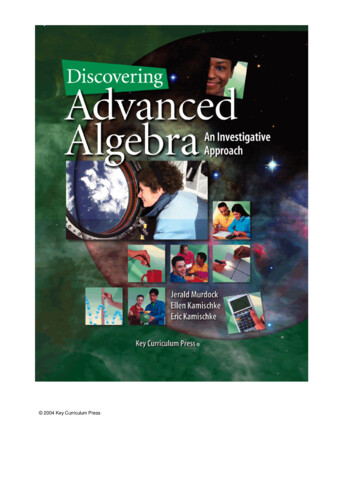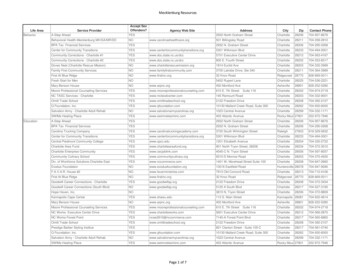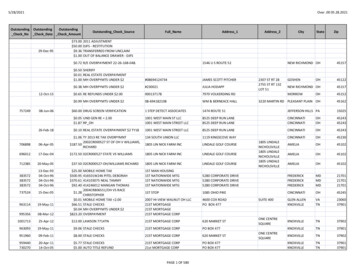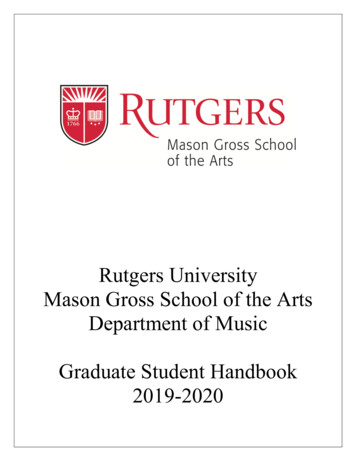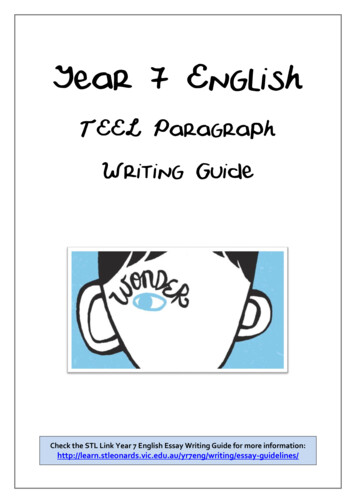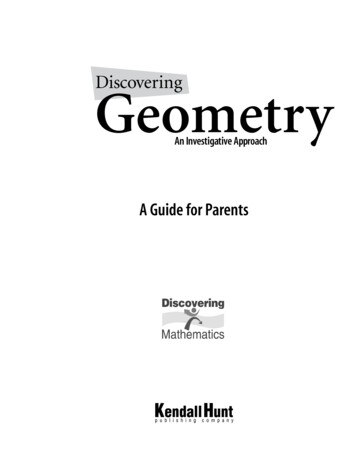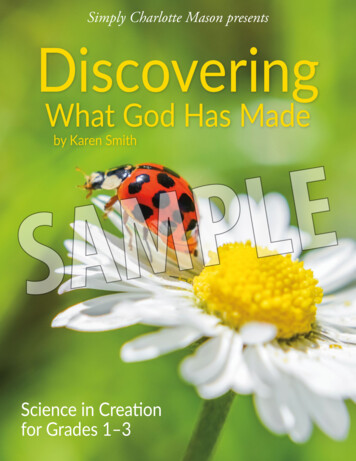
Transcription
Simply Charlotte Mason presentsDiscoveringWhat God Has Madeby Karen Smithfor Grades 1–3
Watch your child’s eyes light up in wonder at themiraculous variety of what God has made!Discover fascinating general science topics that relate to each day ofCreation. The short lessons in this course will be your guide to discovering lightand shadows, water and weather, land and plants, planets and stars, fish andbirds, creeping things, land animals, and the human body.You and your child will read great living science books, conduct simple yetmeaningful experiments, enjoy nature study projects, and create a personalCreation notebook centered around the six days of Creation.Discovering What God Has Made will Nurture within your child a sense of wonder at God's Creation, Cultivate a habit of careful observation that will serve your child well, and Lay the ground work of personal experience that will support future sciencestudies.“O Lord, how manifold are your works! In wisdomhave you made them all . . .” (Psalm 104:24).SimplyCharlotte Mason.com
Discovering WhatGod Has MadeScience in Creation for Grades 1–3by Karen Smith
Discovering What God Has Made: Science in Creation for Grades 1–3 2021 by Karen SmithAll rights reserved. However, we grant permission to make printed copies or use this work on multipleelectronic devices for members of your immediate household. Quantity discounts are available forclassroom and co-op use. Please contact us for details.ISBN 978-1-61634-500-6 printedISBN 978-1-61634-501-3 electronic downloadPublished bySimply Charlotte Mason, LLC930 New Hope Road #11-892Lawrenceville, Georgia 30045simplycharlottemason.comPrinted by PrintLogic, Inc.Monroe, Georgia, USA
ContentsIntroduction . . . . . . . . . . . . . . . . . . . . . . . . . . . . . . . . . . . . . . . . . . . . . . . . . . . . . . . . . . . . . . . . . . . . . . . . . . . 5A Word about Nature Notebooks . . . . . . . . . . . . . . . . . . . . . . . . . . . . . . . . . . . . . . . . . . . . . . . . . . . . . . . 6Resources Needed: Complete List . . . . . . . . . . . . . . . . . . . . . . . . . . . . . . . . . . . . . . . . . . . . . . . . . . . . . . . 7Resources Needed: By Term . . . . . . . . . . . . . . . . . . . . . . . . . . . . . . . . . . . . . . . . . . . . . . . . . . . . . . . . . . . 11Suggested Schedule for a Year of Study . . . . . . . . . . . . . . . . . . . . . . . . . . . . . . . . . . . . . . . . . . . . . . . . 15Lesson 1: God Created . . . . . . . . . . . . . . . . . . . . . . . . . . . . . . . . . . . . . . . . . . . . . . . . . . . . . . . . . . . . . . 17Lesson 2: The Seven Days of Creation . . . . . . . . . . . . . . . . . . . . . . . . . . . . . . . . . . . . . . . . . . . . . . . 17Lesson 3: Creation vs. Evolution . . . . . . . . . . . . . . . . . . . . . . . . . . . . . . . . . . . . . . . . . . . . . . . . . . . . . 17Lesson 4: Day One of Creation: Light . . . . . . . . . . . . . . . . . . . . . . . . . . . . . . . . . . . . . . . . . . . . . . . . 18Lesson 5: Shadows . . . . . . . . . . . . . . . . . . . . . . . . . . . . . . . . . . . . . . . . . . . . . . . . . . . . . . . . . . . . . . . . . 18Lesson 6: Color . . . . . . . . . . . . . . . . . . . . . . . . . . . . . . . . . . . . . . . . . . . . . . . . . . . . . . . . . . . . . . . . . . . . . 19Lesson 7: Day Two of Creation: Separation of Waters and Atmosphere . . . . . . . . . . . . . . . . 19Lesson 8: The Water Cycle . . . . . . . . . . . . . . . . . . . . . . . . . . . . . . . . . . . . . . . . . . . . . . . . . . . . . . . . . . . 20Lesson 9: Wind . . . . . . . . . . . . . . . . . . . . . . . . . . . . . . . . . . . . . . . . . . . . . . . . . . . . . . . . . . . . . . . . . . . . . 20Lesson 10: Clouds . . . . . . . . . . . . . . . . . . . . . . . . . . . . . . . . . . . . . . . . . . . . . . . . . . . . . . . . . . . . . . . . . . 21Lesson 11: Weather . . . . . . . . . . . . . . . . . . . . . . . . . . . . . . . . . . . . . . . . . . . . . . . . . . . . . . . . . . . . . . . . . 21Weather Chart . . . . . . . . . . . . . . . . . . . . . . . . . . . . . . . . . . . . . . . . . . . . . . . . . . . . . . . . . . . . . . . . . . . . . 22Optional Lesson 12: More Weather . . . . . . . . . . . . . . . . . . . . . . . . . . . . . . . . . . . . . . . . . . . . . . . . . . 23Lesson 13: Day Three of Creation: Land and Plants . . . . . . . . . . . . . . . . . . . . . . . . . . . . . . . . . . . 23Lesson 14: Rocks and Minerals . . . . . . . . . . . . . . . . . . . . . . . . . . . . . . . . . . . . . . . . . . . . . . . . . . . . . . 24Lesson 15: Soil . . . . . . . . . . . . . . . . . . . . . . . . . . . . . . . . . . . . . . . . . . . . . . . . . . . . . . . . . . . . . . . . . . . . . 24Lesson 16: Seeds . . . . . . . . . . . . . . . . . . . . . . . . . . . . . . . . . . . . . . . . . . . . . . . . . . . . . . . . . . . . . . . . . . . 25Lesson 17: Plants . . . . . . . . . . . . . . . . . . . . . . . . . . . . . . . . . . . . . . . . . . . . . . . . . . . . . . . . . . . . . . . . . . . 25Optional Lesson 18: More Plants . . . . . . . . . . . . . . . . . . . . . . . . . . . . . . . . . . . . . . . . . . . . . . . . . . . . 26Lesson 19: Mushrooms . . . . . . . . . . . . . . . . . . . . . . . . . . . . . . . . . . . . . . . . . . . . . . . . . . . . . . . . . . . . . 27Optional Lesson 20: Examining Mushrooms . . . . . . . . . . . . . . . . . . . . . . . . . . . . . . . . . . . . . . . . . 27Lesson 21: Trees . . . . . . . . . . . . . . . . . . . . . . . . . . . . . . . . . . . . . . . . . . . . . . . . . . . . . . . . . . . . . . . . . . . . 28Lesson 22: Food From Plants . . . . . . . . . . . . . . . . . . . . . . . . . . . . . . . . . . . . . . . . . . . . . . . . . . . . . . . . 28Lesson 23: Plant Life . . . . . . . . . . . . . . . . . . . . . . . . . . . . . . . . . . . . . . . . . . . . . . . . . . . . . . . . . . . . . . . . 29Lesson 24: Day Four of Creation: The Sun, Moon, and Stars . . . . . . . . . . . . . . . . . . . . . . . . . . . 29Lesson 25: The Sun & Day and Night . . . . . . . . . . . . . . . . . . . . . . . . . . . . . . . . . . . . . . . . . . . . . . . . 29Lesson 26: Catch Up or Exam . . . . . . . . . . . . . . . . . . . . . . . . . . . . . . . . . . . . . . . . . . . . . . . . . . . . . . . 30Lesson 27: Catch Up or Exam . . . . . . . . . . . . . . . . . . . . . . . . . . . . . . . . . . . . . . . . . . . . . . . . . . . . . . . 30Lesson 28: The Moon . . . . . . . . . . . . . . . . . . . . . . . . . . . . . . . . . . . . . . . . . . . . . . . . . . . . . . . . . . . . . . . 30Optional Lesson 29: Astronaut Neil Armstrong . . . . . . . . . . . . . . . . . . . . . . . . . . . . . . . . . . . . . . 31Lesson 30: The Stars . . . . . . . . . . . . . . . . . . . . . . . . . . . . . . . . . . . . . . . . . . . . . . . . . . . . . . . . . . . . . . . . 31Lesson 31: The Solar System . . . . . . . . . . . . . . . . . . . . . . . . . . . . . . . . . . . . . . . . . . . . . . . . . . . . . . . . 31Optional Lesson 32: The Order of the Planets . . . . . . . . . . . . . . . . . . . . . . . . . . . . . . . . . . . . . . . . 32Lesson 33: Day Five of Creation: Aquatic Life and Winged Creatures . . . . . . . . . . . . . . . . . . 32Lesson 34: Seahorses . . . . . . . . . . . . . . . . . . . . . . . . . . . . . . . . . . . . . . . . . . . . . . . . . . . . . . . . . . . . . . . 33Lesson 35: Octopuses . . . . . . . . . . . . . . . . . . . . . . . . . . . . . . . . . . . . . . . . . . . . . . . . . . . . . . . . . . . . . . 33Optional Lesson 36: Oceanographer Sylvia Earle . . . . . . . . . . . . . . . . . . . . . . . . . . . . . . . . . . . . . 33Lesson 37: Salmon . . . . . . . . . . . . . . . . . . . . . . . . . . . . . . . . . . . . . . . . . . . . . . . . . . . . . . . . . . . . . . . . . 34
Optional Lesson 38: Aquarium Field Trip . . . . . . . . . . . . . . . . . . . . . . . . . . . . . . . . . . . . . . . . . . . .Lesson 39: Birds . . . . . . . . . . . . . . . . . . . . . . . . . . . . . . . . . . . . . . . . . . . . . . . . . . . . . . . . . . . . . . . . . . . .Lesson 40: Emus . . . . . . . . . . . . . . . . . . . . . . . . . . . . . . . . . . . . . . . . . . . . . . . . . . . . . . . . . . . . . . . . . . . .Lesson 41: Loons . . . . . . . . . . . . . . . . . . . . . . . . . . . . . . . . . . . . . . . . . . . . . . . . . . . . . . . . . . . . . . . . . . .Lesson 42: Peregrine Falcons and Migration . . . . . . . . . . . . . . . . . . . . . . . . . . . . . . . . . . . . . . . . .Optional Lesson 43: Owls . . . . . . . . . . . . . . . . . . . . . . . . . . . . . . . . . . . . . . . . . . . . . . . . . . . . . . . . . . .Lesson 44: Entomologist Jean-Henri Fabre . . . . . . . . . . . . . . . . . . . . . . . . . . . . . . . . . . . . . . . . . .Lesson 45: Butterflies . . . . . . . . . . . . . . . . . . . . . . . . . . . . . . . . . . . . . . . . . . . . . . . . . . . . . . . . . . . . . . .Lesson 46: Honeybees . . . . . . . . . . . . . . . . . . . . . . . . . . . . . . . . . . . . . . . . . . . . . . . . . . . . . . . . . . . . . .Optional Lesson 47: Ants . . . . . . . . . . . . . . . . . . . . . . . . . . . . . . . . . . . . . . . . . . . . . . . . . . . . . . . . . . .Lesson 48: Day Six of Creation: Land Animals and Creeping Things . . . . . . . . . . . . . . . . . . .Lesson 49: Spiders . . . . . . . . . . . . . . . . . . . . . . . . . . . . . . . . . . . . . . . . . . . . . . . . . . . . . . . . . . . . . . . . . .Lesson 50: Pill Bugs . . . . . . . . . . . . . . . . . . . . . . . . . . . . . . . . . . . . . . . . . . . . . . . . . . . . . . . . . . . . . . . . .Lesson 51: Earthworms . . . . . . . . . . . . . . . . . . . . . . . . . . . . . . . . . . . . . . . . . . . . . . . . . . . . . . . . . . . . .Lesson 52: Turtles . . . . . . . . . . . . . . . . . . . . . . . . . . . . . . . . . . . . . . . . . . . . . . . . . . . . . . . . . . . . . . . . . .Lesson 53: Snakes . . . . . . . . . . . . . . . . . . . . . . . . . . . . . . . . . . . . . . . . . . . . . . . . . . . . . . . . . . . . . . . . . .Lesson 54: Chameleons . . . . . . . . . . . . . . . . . . . . . . . . . . . . . . . . . . . . . . . . . . . . . . . . . . . . . . . . . . . . .Optional Lesson 55: Crocodiles . . . . . . . . . . . . . . . . . . . . . . . . . . . . . . . . . . . . . . . . . . . . . . . . . . . . .Lesson 56: Frogs . . . . . . . . . . . . . . . . . . . . . . . . . . . . . . . . . . . . . . . . . . . . . . . . . . . . . . . . . . . . . . . . . . . .Lesson 57: Catch Up or Exam . . . . . . . . . . . . . . . . . . . . . . . . . . . . . . . . . . . . . . . . . . . . . . . . . . . . . . .Lesson 58: Catch Up or Exam . . . . . . . . . . . . . . . . . . . . . . . . . . . . . . . . . . . . . . . . . . . . . . . . . . . . . . .Lesson 59: Toads . . . . . . . . . . . . . . . . . . . . . . . . . . . . . . . . . . . . . . . . . . . . . . . . . . . . . . . . . . . . . . . . . . .Lesson 60: Salamanders . . . . . . . . . . . . . . . . . . . . . . . . . . . . . . . . . . . . . . . . . . . . . . . . . . . . . . . . . . . .Lesson 61: Bears . . . . . . . . . . . . . . . . . . . . . . . . . . . . . . . . . . . . . . . . . . . . . . . . . . . . . . . . . . . . . . . . . . . .Lesson 62: Beavers . . . . . . . . . . . . . . . . . . . . . . . . . . . . . . . . . . . . . . . . . . . . . . . . . . . . . . . . . . . . . . . . .Lesson 63: Platypuses . . . . . . . . . . . . . . . . . . . . . . . . . . . . . . . . . . . . . . . . . . . . . . . . . . . . . . . . . . . . . .Lesson 64: Caribou . . . . . . . . . . . . . . . . . . . . . . . . . . . . . . . . . . . . . . . . . . . . . . . . . . . . . . . . . . . . . . . . .Optional Lesson 65: Zoo Field Trip . . . . . . . . . . . . . . . . . . . . . . . . . . . . . . . . . . . . . . . . . . . . . . . . . .Lesson 66: Day Six of Creation: Man and Woman . . . . . . . . . . . . . . . . . . . . . . . . . . . . . . . . . . . .Lesson 67: Skin . . . . . . . . . . . . . . . . . . . . . . . . . . . . . . . . . . . . . . . . . . . . . . . . . . . . . . . . . . . . . . . . . . . . .Lesson 68: The Nervous System: The Brain . . . . . . . . . . . . . . . . . . . . . . . . . . . . . . . . . . . . . . . . . . .Lesson 69: The Nervous System: Nerves . . . . . . . . . . . . . . . . . . . . . . . . . . . . . . . . . . . . . . . . . . . . .Lesson 70: The Senses: Sight . . . . . . . . . . . . . . . . . . . . . . . . . . . . . . . . . . . . . . . . . . . . . . . . . . . . . . . .Lesson 71: The Senses: Sound, Smell, Taste, and Touch . . . . . . . . . . . . . . . . . . . . . . . . . . . . . . .Lesson 72: Reflexes . . . . . . . . . . . . . . . . . . . . . . . . . . . . . . . . . . . . . . . . . . . . . . . . . . . . . . . . . . . . . . . . .Lesson 73: The Circulatory System . . . . . . . . . . . . . . . . . . . . . . . . . . . . . . . . . . . . . . . . . . . . . . . . . .Lesson 74: The Respiratory System . . . . . . . . . . . . . . . . . . . . . . . . . . . . . . . . . . . . . . . . . . . . . . . . . .Lesson 75: The Digestive System, Part 1 . . . . . . . . . . . . . . . . . . . . . . . . . . . . . . . . . . . . . . . . . . . . .Lesson 76: The Digestive System, Part 2 . . . . . . . . . . . . . . . . . . . . . . . . . . . . . . . . . . . . . . . . . . . . .Lesson 77: The Skeletal System . . . . . . . . . . . . . . . . . . . . . . . . . . . . . . . . . . . . . . . . . . . . . . . . . . . . .Lesson 78: The Muscular System . . . . . . . . . . . . . . . . . . . . . . . . . . . . . . . . . . . . . . . . . . . . . . . . . . . .Lesson 79: The Immune System . . . . . . . . . . . . . . . . . . . . . . . . . . . . . . . . . . . . . . . . . . . . . . . . . . . . .Lesson 80: Day Seven of Creation: Rest . . . . . . . . . . . . . . . . . . . . . . . . . . . . . . . . . . . . . . . . . . . . . .Lesson 81: Catch Up or Exam . . . . . . . . . . . . . . . . . . . . . . . . . . . . . . . . . . . . . . . . . . . . . . . . . . . . . . .Lesson 82: Review . . . . . . . . . . . . . . . . . . . . . . . . . . . . . . . . . . . . . . . . . . . . . . . . . . . . . . . . . . . . . . . . . 44444444545464646474848484949505050515151
IntroductionDuring the elementary years, your science lessons should accomplish three things:1. Nurture within the child a sense of wonder at God’s Creation.2. Cultivate a habit of careful observation.3. Lay the groundwork of personal experience that will support future science studies.The lessons in this book strive to accomplish those three goals. They are intended for children in first,second, and third grades and are based on the seven days of Creation as recorded in the Bible. I have simplycollected book titles and some additional ideas to encourage you and your child to explore more about thegeneral science topics that relate to each day of Creation.A suggested schedule is provided on page 15. Most weeks have two lessons to complete. There areoptional lessons that you may choose whether to complete. Feel free to do some, all, or none of them.Book of Centuries dates are provided in case you want to add scientists from this study to that timeline.At the time of this publishing, all of the book suggestions listed in the lessons were in print, unlessotherwise noted. If you cannot find one of the titles, feel free to substitute a different book on the sametopic. Likewise, all of the internet links worked at the time of publishing. If an internet link is no longerworking, feel free to search for another one. I hope you enjoy these ideas for encouraging your child toexplore nature!simplycharlottemason.com5
A Word about Nature NotebooksThroughout the lessons in this book, you will see references to a “Creation notebook.” A Creation notebookis simply a nature notebook that is focused on the days of Creation. I recommend a three-ring binder to beused for this study. Your child’s Creation notebook will become his personal record of what he has observedand made a personal relation with during this study.Here are some key points to remember about a nature notebook:1. A nature notebook is the child’s own possession. It is not to be graded or critiqued. It is not theparent’s project; it belongs to the child.2. A nature notebook can contain written observations, drawings, poetry, Scripture, specimens—whatever interests the child and encourages him to look closely and observe nature carefully.3. If the child isn’t able to or comfortable with writing his observations in his nature notebook, theparent can do the writing as the child dictates what he wants to say.Choosing a Field GuideA good field guide is an essential tool for doing nature study. It will help you identify plants, animals,insects, etc. in nature and give you some basic information about the natural items you are studying. Choosea field guide with good pictures, written descriptions of the organisms, range maps, common names as wellas Latin names, and a description of the habitat and basic habits of the organisms. There are many choicesavailable for field guides, from regional books to digital apps. Choose the ones you will use and that will bethe most useful to you. You can watch a helpful video on choosing and using field guides at simplycm.com/dwghm.6simplycharlottemason.com
Resources NeededComplete ListThroughout the study Bible Favorite Poems Old and New selected by Helen Ferris—This wonderful collection of poems will be ahandy resource for all your homeschooling years. (optional) Handbook of Nature Study by Anna Botsford Comstock—This book is available free onlineand is a reference for the teacher to study and to learn about the science topics ahead of time. Somelesson ideas are also given. Corresponding pages are listed for your convenience if you would like touse this resource as a supplement. (optional) Rocks & Minerals field guide Flowers field guide Trees field guide Birds field guide Insects field guide Reptiles & Amphibians field guideFor specific lessons (Check your library.) Yellow and Pink by William SteigAll the Colors of the Rainbow by Allan FowlerA Drop Around the World by Barbara Shaw McKinneyThe Wind Blew by Pat HutchinsLet’s-Read-and-Find-Out Science: Clouds by Anne Rockwell(optional) On the Same Day in March by Marilyn SingerJulie the Rockhound by Gail Langer KarwoskiJump Into Science: Dirt by Steve TomecekCactus Hotel by Brenda Z. GuibersonThe Reason for a Flower: A Book About Flowers, Pollen and Seeds by Ruth HellerKatya’s Book of Mushrooms by Katya Arnold and Sam Swope (available as an ebook)In a Nutshell by Joseph AnthonyA Weed is a Flower: The Life of George Washington Carver by AlikiJump Into Science: Sun by Steve TomecekMoonfinder by Jay Ryan (This book can be purchased at christianbook.com.)(optional) One Giant Leap: The Story of Neil Armstrong by Don BrownThe Sky Is Full of Stars by Franklyn M. Branleysimplycharlottemason.com7
What’s So Special About Planet Earth? by Robert E. WellsSeahorses by Jennifer Keats CurtisAn Octopus Is Amazing by Patricia Lauber(optional) Life in the Ocean: The Story of Oceanographer Sylvia Earle by Claire NivolaSalmon Stream by Carol Reed-JonesCrow Not Crow by Jane Yolen and Adam StempleEmu by Claire SaxbyLoon by Susan Vande GriekThe Peregrine’s Journey: A Story of Migration by Madeleine Dunphy(optional) Adopted by an Owl: The True Story of Jackson the Owl by Robbyn Smith van FrankenhuyzenSmall Wonders: Jean-Henri Fabre & His World of Insects by Matthew Clark SmithWhere Butterflies Grow by Joanne RyderThe Honeybee Man by Lela NargiSpinning Spiders by Melvin BergerNext Time You See a Pill Bug by Emily MorganWiggling Worms at Work by Wendy PfefferBox Turtle at Long Pond by William T. GeorgeAmazing Snakes! by Sarah L. ThomsonChameleons Are Cool by Martin Jenkins(optional) Crocodile Safari by Jim Arnosky (out of print)Hip-Pocket Papa by Sandra MarkleSalamander Season by Jennifer Keats CurtisFraser Bear: A Cub’s Life by Maggie de VriesBuild, Beaver, Build: Life at the Longest Beaver Dam by Sandra MarklePlatypus by Sue WhitingA Caribou Journey by Debbie S. MillerYour Skin and Mine by Paul ShowersThe Astounding Nervous System: How Does My Brain Work? by John BursteinThe Five Senses by Jennifer PriorWhy I Sneeze, Shiver, Hiccup, and Yawn by Melvin BergerThe Amazing Circulatory System: How Does My Heart Work? by John BursteinThe Remarkable Respiratory System: How Do My Lungs Work? by John BursteinThe Dynamic Digestive System: How Does My Stomach Work? by John BursteinThe Mighty Muscular-Skeletal System: How Do My Bones and Muscles Work? by John BursteinGerms Make Me Sick! by Melvin BergerFor narrations, experiments, and nature studies 8Three-ring binders, one for each student (for Creation notebooks)Blank paper(optional) Construction paper or other colored paperArt supplies: colored pencils, felt-tip markers, paints, crayonssimplycharlottemason.com
(optional) Candle(optional) MatchSidewalk chalkBlue construction paperCotton ballsGlueGlobe or world mapMagnifying glassRocks(optional) A set of labeled rocks from a science supplier such as ks-minerals/ or ocks-minerals.Quart size jar with lidGarden trowel or shovelDirt from your yardSmall glass jarPaper towel3–4 dried beans or bean seeds(optional) Two glasses of water(optional) Stalk of celery with leaves or two white carnations(optional) Liquid food coloring(optional) Whole mushroomsFlashlightGlobe or large ball such as a basketball(optional) Internet-connected computerBird feederBlack oil sunflower seeds(optional) Hummingbird feeder(optional) Sugar(optional) Boiling water(optional) Heat-proof container(optional) Jar with lidLarge roll of paper such as butcher paper or freezer paperMirrorA fragrant flower such as a rose or carnationCinnamonVanillaAn appleSaltA lemonsimplycharlottemason.com9
Resources NeededBy TermLessons 1–27Books BibleYellow and Pink by William SteigFavorite Poems Old and New selected by Helen FerrisAll the Colors of the Rainbow by Allan FowlerA Drop Around the World by Barbara Shaw McKinneyThe Wind Blew by Pat HutchinsLet’s-Read-and-Find-Out Science: Clouds by Anne Rockwell(optional) On the Same Day in March by Marilyn SingerJulie the Rockhound by Gail Langer Karwoski(optional) Rocks and Minerals field guideJump Into Science: Dirt by Steve TomecekCactus Hotel by Brenda Z. GuibersonThe Reason for a Flower: A Book About Flowers, Pollen and Seeds by Ruth HellerKatya’s Book of Mushrooms by Katya Arnold and Sam Swope (available as an ebook)In a Nutshell by Joseph AnthonyTrees field guideA Weed is a Flower: The Life of George Washington Carver by AlikiFlowers field guideJump Into Science: Sun by Steve TomecekOther Resources Blank paperArt supplies: colored pencils, felt-tip markers, paint, crayonsThree-ring binder (Creation Notebook), one for each child(optional) Construction paper or other colored paper(optional) Candle(optional) MatchSidewalk chalkBlue construction paperCotton ballsGlueGlobe or world mapsimplycharlottemason.com11
Rocks from your yard(optional) Purchased set of rocksMagnifying glassQuart-size jar with lidGarden trowel or shovelDirt from your yardPaper towelSmall glass jar3–4 dried beans or bean seedsFresh flowers(optional) Two glasses of water(optional) Stalk of celery with leaves or two white carnations(optional) Liquid food coloring(optional) Whole mushroomsGlobe or large ball, such as a basketballFlashlightLessons 28–58Books 12Moonfinder by Jay Ryan (This book can be purchased christianbook.com.)(optional) One Giant Leap: The Story of Neil Armstrong by Don BrownThe Sky Is Full of Stars by Franklyn M. BranleyWhat’s So Special About Planet Earth? by Robert E. WellsBibleSeahorses by Jennifer Keats CurtisAn Octopus Is Amazing by Patricia Lauber(optional) Life in the Ocean: The Story of Oceanographer Sylvia Earle by Claire NivolaSalmon Stream by Carol Reed-JonesCrow Not Crow by Jane Yolen and Adam StempleEmu by Claire SaxbyBirds field guideLoon by Susan Vande GriekThe Peregrine’s Journey: A Story of Migration by Madeleine Dunphy(optional) Adopted by an Owl: The True Story of Jackson the Owl by Robbyn Smith van FrankenhuyzenSmall Wonders: Jean-Henri Fabre & His World of Insects by Matthew Clark SmithInsects field guideWhere Butterflies Grow by Joanne RyderThe Honeybee Man by Lela NargiFavorite Poems Old and New selected by Helen FerrisSpinning Spiders by Melvin Bergersimplycharlottemason.com
Next Time You See a Pill Bug by Emily MorganWiggling Worms at Work by Wendy PfefferBox Turtle at Long Pond by William T. GeorgeReptiles & Amphibians field guideAmazing Snakes! by Sarah L. ThomsonChameleons Are Cool by Martin Jenkins(optional) Crocodile Safari by Jim Arnosky (out of print)Hip-Pocket Papa by Sandra MarkleOther Resources Blank paperArt supplies: colored pencils, felt-tip markers, paint, crayonsCreation notebook(optional) Construction paper or other colored paper(optional) Internet-connected computerBird feederBlack oil sunflower seeds(optional) Hummingbird feeder(optional) Sugar(optional) Boiling water(optional) Heat-proof container(optional) Jar with lid(optional) Magnifying glassLessons 59–82Books Favorite Poems Old and New selected by Helen FerrisReptiles & Amphibians field guideSalamander Season by Jennifer Keats CurtisFraser Bear: A Cub’s Life by Maggie de VriesBuild, Beaver, Build: Life at the Longest Beaver Dam by Sandra MarklePlatypus by Sue WhitingA Caribou Journey by Debbie S. MillerBibleYour Skin and Mine by Paul ShowersThe Astounding Nervous System: How Does My Brain Work? by John BursteinThe Five Senses by Jennifer PriorWhy I Sneeze, Shiver, Hiccup, and Yawn by Melvin BergerThe Amazing Circulatory System: How Does My Heart Work? by John BursteinThe Remarkable Respiratory System: How Do My Lungs Work? by John Bursteinsimplycharlottemason.com13
The Dynamic Digestive System: How Does My Stomach Work? by John Burstein The Mighty Muscular–Skeletal System: How Do My Bones and Muscles Work? by John Burstein Germs Make Me Sick! by Melvin BergerOther Resources 14Blank paperArt supplies: colored pencils, felt-tip markers, paint, crayonsCreation notebookLarge roll of paper such as butcher paper or freezer paperMarkersMirrorA fragrant flower, such as a rose or carnationCinnamonVanillaAn appleSaltA lemon(optional) Construction paper or other colored papersimplycharlottemason.com
Suggested Schedule for a Year of StudyWeek 1: Lessons 1 and 2Week 2: Lessons 3 and 4Week 3: Lessons 5 and 6Week 4: Lessons 7 and 8Week 5: Lessons 9 and 10Week 6: Lessons 11 and 13 and Optional Lesson 12Week 7: Lessons 14 and 15Week 8: Lessons 16 and 17 and Optional Lesson 18Week 9: Lessons 19 and 21 and Optional Lesson 20Week 10: Lessons 22 and 23Week 11: Lessons 24 and 25Week 12: Lessons 26 and 27: Catch Up or ExamWeek 13: Lessons 28 and 30 and Optional Lesson 29Week 14: Lessons 31 and 33 and Optional Lesson 32Week 15: Lessons 34 and 35 and Optional Lesson 36Week 16: Lessons 37 and 39 and Optional Lesson 38Week 17: Lessons 40 and 41Week 18: Lessons 42 and 44 and Optional Lesson 43Week 19: Lessons 45 and 46 and Optional Lesson 47Week 20: Lessons 48 and 49Week 21: Lessons 50 and 51Week 22: Lessons 52 and 53Week 23: Lessons 54 and 56 and Optional Lesson 55Week 24: Lessons 57 and 58: Catch Up or ExamWeek 25: Lessons 59 and 60Week 26: Lessons 61 and 62Week 27: Lessons 63 and 64 and Optional Lesson 65Week 28: Lessons 66 and 67Week 29: Lessons 68 and 69Week 30: Lessons 70 and 71Week 31: Lessons 72 and 73Week 32: Lessons 74 and 75Week 33: Lessons 76 and 77Week 34: Lessons 78 and 79Week 35: Lesson 80 and Lesson 81: Catch Up or ExamWeek 36: Lesson 82: Reviewsimplycharlottemason.com15
Discovering What God Has MadeLesson 1: God CreatedChecklist Blank paper Colored pencils or felt-tip markers Three-ring binders, one for each childNotesReminder: Get Yellow andPink by William Steig forLesson 3.Have your child design and decorate a cover for his Creation notebook. Puthis designed cover into a three-ring binder, which will become his Creationnotebook for this study. Your child will add to his notebook as the studyprogresses.Lesson 2: The Seven Daysof CreationChecklist BibleBlank paperColored pencilsCreation notebookRead aloud Genesis 1:1—2:3. Stop after each day’s description and haveyour child draw what God made. Your child may draw on seven different sheetsof paper to represent the seven days, or draw seven circles on one paper (onefor each day), or however he would like to represent the seven days.Have your child narrate the days of Creation by explaining his drawings.Add the drawings to his Creation notebook.Lesson 3: Creation vs. EvolutionChecklist Yellow and PinkRead aloud Yellow and Pink by William Steig. Briefly discuss the theory ofevolution and how the story of Yellow and Pink relates to it.simplycharlottemason.comReminder: Get All theColors of the Rainbow byAllan Fowler for Lesson 6.17
Discovering What God Has MadeNotesLesson 4: Day One of Creation: LightChecklist BibleBlank paper(optional) Construction paper or other colored paperColored pencils or felt-tip markersCreation notebook(optional) Candle(optional) MatchRead aloud Genesis 1:3–5.Narration Prompt: Ask your child to tell what he knows about the first dayof Creation.Talk about and demonstrate different kinds of light: fire, electric, sunlight.Go to a dark room in your house. Let your child experience the darkness for afew minutes, then turn on the light or carefully light a candle to show how thedarkness cannot exist in the light.Have your child design and draw a title page for Day One of Creation. Youmight want to make the title pages out of construction paper or other coloredpaper so the Day divisions will be easily distinguishable in the notebook. Addt
and shadows, water and weather, land and plants, planets and stars, sh and . ISBN 978-1-61634-501-3 electronic download Published by Simply Charlotte Mason, LLC 930 New Hope Road #11-892 . Handbook of Nature Study by Anna Botsford Comstock—This book is available free online and is a reference for the teacher to study and to learn about .


